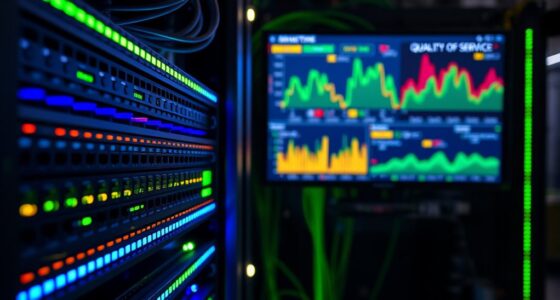It’s no coincidence that as you increasingly rely on connected devices, the future of networking is shifting toward 5G and beyond. These advancements promise smarter, faster, and more reliable connections, but what’s truly on the horizon may change how you live and work in ways you haven’t expected. Understanding these emerging technologies can prepare you for a world where seamless digital experiences become the norm—if you’re willing to explore what’s next.
Key Takeaways
- 5G and beyond focus on higher speeds, smarter networks, and seamless digital integration with widespread IoT connectivity.
- AI optimizes network performance, predicts issues, and enhances security through real-time threat detection.
- Future networks prioritize ultra-reliable low-latency communication (URLLC) and support immersive AR/VR experiences.
- IoT forms the backbone of interconnected systems, enabling devices to coordinate, learn, and optimize energy use.
- Enhanced user benefits include faster, more reliable connections and immersive, high-definition digital experiences.

Have you ever wondered what the future of networking looks like? As technology advances, the networks that connect our devices will become faster, smarter, and more integrated than ever before. One of the most exciting developments on this horizon is the continued evolution of 5G and what lies beyond. This next-generation connectivity isn’t just about higher speeds; it’s about creating a more intelligent, seamless digital environment. With IoT integration becoming increasingly widespread, your world will be more interconnected, with devices communicating efficiently to improve your daily life. Smart homes, wearable health devices, and autonomous vehicles will rely heavily on this interconnected web, making everything more responsive and tailored to your needs.
AI optimization plays an essential role in shaping this future. Network systems will leverage artificial intelligence to manage traffic, predict issues, and optimize performance proactively. Imagine a network that learns from your usage patterns and adjusts resources to guarantee minimal latency and maximum reliability. This AI-driven approach will enable your devices to operate more smoothly, with fewer disruptions and faster data transfers. As networks become smarter, they’ll also become more secure, employing AI to detect and neutralize threats in real-time, keeping your personal information safer than ever before.
Beyond 5G, researchers are already exploring technologies that will push connectivity even further. These future networks aim to support the exponential growth of connected devices through innovations like ultra-reliable low-latency communication and massive machine-type communications. You’ll see a world where augmented reality, virtual reality, and high-definition streaming become more immersive and accessible. The infrastructure will adapt dynamically, ensuring that even as the number of connected devices skyrockets, your experience remains seamless and uninterrupted. Additionally, advancements in sound design techniques are being integrated into virtual environments to enhance immersion and user engagement.
Future networks will support immersive AR, VR, and seamless high-definition streaming through dynamic, ultra-reliable connectivity.
In this evolving landscape, IoT integration isn’t just a feature; it’s the foundation. Your devices will work together in ways that today seem like science fiction—coordinating actions, sharing data, and learning from each other to optimize everyday tasks. AI optimization will make these interactions more efficient, reducing energy consumption and improving overall network health. As a user, you’ll benefit from faster speeds, more reliable connections, and smarter services that anticipate your needs. It’s a future where networking isn’t just about connecting devices; it’s about creating a responsive, intelligent ecosystem that works effortlessly to support your lifestyle.
Frequently Asked Questions
How Will 6G Differ From 5G in Terms of Speed?
You’ll notice that 6G will substantially surpass 5G in speed, leveraging broader spectrum requirements to achieve ultra-fast data transfer rates. Expect latency improvements, making your online experiences smoother and more responsive. With 6G, you’ll enjoy seamless connectivity for immersive applications like virtual reality and AI-driven services, all while benefiting from enhanced spectrum use and reduced delays. It’s a leap toward faster, more efficient wireless communication.
What Challenges Exist for Global 5G Infrastructure Deployment?
You face challenges like spectrum allocation and infrastructure funding when deploying global 5G. Governments must assign enough spectrum for 5G bands, which can be complex and politically sensitive. Securing funding for infrastructure, especially in rural or developing areas, also proves difficult. These hurdles slow down widespread rollout, requiring strategic planning, international cooperation, and investment to ensure reliable, high-speed 5G connectivity worldwide.
How Will 5G Impact Emerging Technologies Like Iot?
You’ll see 5G greatly boost IoT by enabling near-instant responses and massive device connectivity. With the ability to handle over a million devices per square kilometer, IoT scalability skyrockets. Plus, 5G’s reduced network latency—down to 1 millisecond—means smarter cities, autonomous vehicles, and real-time health monitoring become possible. This technology transforms industries by making IoT applications faster, more reliable, and capable of supporting future innovations.
What Are the Cybersecurity Risks Associated With 5G Networks?
You face increased cybersecurity risks with 5G networks, including potential network intrusions and data privacy breaches. The expanded attack surface means hackers can exploit vulnerabilities more easily, risking sensitive information and network integrity. You need strong security measures, like encryption and intrusion detection, to protect your data privacy and prevent unauthorized access. Staying vigilant helps you mitigate these risks as 5G adoption grows and network complexities increase.
When Can Consumers Expect Widespread 6G Adoption?
Think of 6G timelines as a horizon inching closer—you probably won’t see widespread consumer adoption until around 2030. Experts suggest that by then, you’ll notice 6G’s lightning-fast speeds and ultra-reliable connections becoming part of everyday life. While early research and development are underway now, it’ll take years for 6G to mature and reach consumers, so patience is key. Expect to see small-scale trials before mass adoption takes hold.
Conclusion
As you embrace the future of networking, remember that the sky’s the limit. With 5G and beyond, you’ll experience faster, smarter, and more reliable connections that will seamlessly integrate into your daily life. This rapid evolution might seem like a tall order now, but it’s all within reach. Stay curious and adaptable—because in this fast-paced digital world, you’ll want to stay ahead of the curve and make the most of these game-changing technologies.







